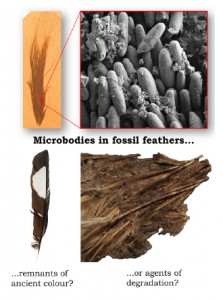
The color of dinosaurs is a fascinating topic, and in recent years the discovery of melanosomes – small, pigment-filled sacs – associated with fossilized dinosaur feathers has given rise to all sorts of speculation about our prehistoric pals, from the hue of their plumage to color’s impact on behavior.
It all sounds wonderful – but how do we know that the melanosomes found in the fossils are actually melanosomes and not something else, like leftover impressions from the microbes (some of which also make melanin) that coated the feather during its decay and preservation? And if they are melanosomes, how can we be sure that the melanin they contained was the only color expression mechanism present?
With current methods, which rely heavily on electron microscopy, it’s hard to be sure. Scientists can identify the shapes and sizes of the melanosomes, and sometimes even the outer texture produced by the grains of pigment within, but images don’t give the full story. Fortunately, advances in molecular analysis are giving paleontologists tools that can help them determine exactly what those shapes mean.
NC State paleontologist Mary Schweitzer became an expert on molecular paleontology when she found soft tissue preserved in a fossilized T. rex femur. Since then, she’s explored ways to use molecular analytical techniques in order to discover whether tissues, cells and proteins can persist through the fossilization process. Now, in a paper published in BioEssays, Schweitzer, doctoral candidate Alison Moyer and co-author Johan Lindgren from Lund University in Sweden outline the challenges that face researchers who want to determine dinosaur color. They suggest ways that molecular analysis can be brought to bear on color preservation in dinosaur feathers and urge other researchers to go the extra mile before claiming color.
“The primary evidence for melanosomes has been shape – elongate or round,” Schweitzer says. “But microbes can also be elongate or round. And the majority of ‘colored dinosaur’ papers aren’t looking at the microbodies themselves. Instead, they measure round or elongate impressions, or voids, left by the bodies in some unidentified, amorphous material. Other researchers claim these bodies must be the color-imparting melanosomes, because melanin is such a tough, resistant molecule. But what they show is that voids remain when the melanosomes decay. So doesn’t that mean the material holding the ‘voids’ is more resistant than melanin? I’m interested in how we can test that theory.
“One way is by looking for keratin. Feathers contain keratin. Melanosomes are buried deep within the feather tissue, not on the surface, and they are covered with keratin, which is a very tough protein that has been shown to persist through time. If they are melanosomes, then that amorphous material should be keratin. Why not use molecular analysis to confirm the presence of keratin as well as melanin?”
Moyer’s earlier experiments show that microbes grow on top of feathers as they decay, and they are distributed in the same pattern as published “melanosome” images. Schweitzer and Moyer argue that the same types of analysis could be used to show that the melanosomes belonged to the original animal, not to the microbes that colonized it after death. Time-of-flight secondary ion mass spectrometry (ToF-SIMS) was pioneered by co-author Lindgren to not only identify melanin but also map it to particular areas on a fossil. When ToF-SIMS is used in concert with other technologies, it could cement the argument for either melanosomes or microbes.
But even if all of these technologies show definitively that the structures are melanosomes, it is still questionable how much light they shed on the color of the whole organism. What we can’t tell from these studies is whether dinosaurs, like modern birds, used other pigments besides melanins. In birds these other pigments make feathers green and blue and yellow, but they are not as tough as melanin, and so may not survive.
“We have all these new technologies available to us, and paleontologists are in a unique position now to get answers to questions that were previously out of reach,” Schweitzer says. “It’s a brave new world, which is why we need to be careful and diligent as we lay the groundwork by classifying, measuring and identifying what can and cannot preserve. No one is saying that melanosomes can’t survive in the fossil record, just that we need to use the tools we have to make sure that we’re truly looking at melanosomes, not microbes.”
- Categories:



